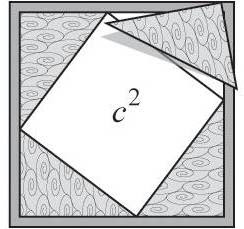Is Geometry your favorite math subject in high school?!
Many people, I met over the years, have expressed affection for Geometry. Arithmetic and Algebra? — not many takers there, but geometry, well there is something about it that brings a twinkle to the eye.
I think it’s because geometry kindles the right side of the brain, which appeals to visual thinkers who might otherwise cringe at its cold logic. But other people tell me they loved geometry precisely because it is so logical. The step-by-step reasoning, with each new theorem resting firmly on those already established — that’s the source of satisfaction for many. For those who couldn’t prove certain theorems, the final verse hence proved was a consolation and trick to confuse the examiner (I am told students still follow it.)
My hunch is that people enjoy it because it marries logic and intuition. It feels good to use both halves of our brain isn’t it?
To illustrate the joys of joymetry, let’s revisit the Pythagorean theorem, which you probably remember as a2 + b2=c2. Part of the goal here is to see why it’s true and appreciate why it matters. Beyond that, by proving the theorem in two different ways, we’ll come to see how one proof can be more “elegant” than another, even though both are correct. =
The Pythagorean theorem is concerned with “right triangles” — meaning those with a right (90-degree) angle at one of the corners. Right triangles are important because they’re what you get if you cut a rectangle in half along its diagonal:

And since rectangles come up often in all sorts of settings, so do right triangles.
They arise, for instance, in surveying. If you’re measuring a rectangular field, you might want to know how far it is from one corner to the diagonally opposite corner. (By the way, this is where geometry started, historically — in problems of land measurement, or measuring the earth: geo = “earth” + metry = “measurement.”)
The Pythagorean theorem tells you how long the diagonal is, compared to the sides of the rectangle. If one side has length a and the other has length b, the theorem says the diagonal has length c, where
For some reason, the diagonal is traditionally called the “hypotenuse,” though I’ve never met anyone who knows why. (Any Latin or Greek scholars there?)
Anyway, here’s how the theorem works. To keep the numbers simple, let’s say a = 3 yards and b = 4 yards. Then to figure out the unknown length c, we add 32 and 42, which, in effect is 9 plus 16. (Keep in mind that all of these quantities are now measured in square yards, since we squared the yards as well as the numbers themselves.) Now, since 9 + 16 = 25, we get c2 = 25 square yards, and then take square roots of both sides. This yields c = 5 yards as the length of the hypotenuse.
This way of looking at the Pythagorean theorem makes it seem like a statement about lengths. But traditionally it was viewed as a statement about areas. That becomes clearer when you say it the way they used to say it:
“The square on the hypotenuse is the sum of the squares on the other two sides.” (Math teachers note this)
Notice the word “on.” We’re not speaking of the square “of” the hypotenuse — that’s a excessively modern algebraic concept about multiplying a number (the length of the hypotenuse) by itself C x C. No, we’re literally referring here to a square sitting on the hypotenuse, like this:
Let’s call this the large square, to distinguish it from the small and medium-sized squares we can build on the other two sides:
Then the theorem says that the large square has the same area as the small and medium squares combined.
Since time immemorial, this marvelous fact has been expressed in a diagram shown below.
Next













